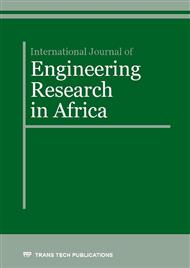[1]
C.J. Luis, I. Puertas, G. Villa, Material removal rate and electrode wear study on the EDM of silicon carbide, J. Mater. Process. Tech. 164(16) (2005) 889- 896.
DOI: 10.1016/j.jmatprotec.2005.02.045
Google Scholar
[2]
P. R. Kubade, An Experimental Investigation of Electrode Wear Rate (EWR), Material Removal Rate (MRR) and Radial Overcut (ROC) in EDM of High Carbon-High Chromium Steel (AISI D3), Int. J. Eng. Adv. Tech. (IJEAT). 1(5) (2012) 135-140.
Google Scholar
[3]
S. Dewangan, C.K. Biswas, Optimization of machining parameters using grey relation analysis for EDM with impulse flushing, Int. J. Mechatron. Manuf. Syst. 6(2), (2013)144-158.
DOI: 10.1504/ijmms.2013.053826
Google Scholar
[4]
A. Iqbal, A.K.M., A.A. Khan, Influence of Process Parameters on Electrical Discharge Machined Job Surface Integrity, Am. J. Eng. Appl. Sci. 3(2) (2010) 396-402.
DOI: 10.3844/ajeassp.2010.396.402
Google Scholar
[5]
P. Goninan, S.S. Joshi, Experimental characterization of material removal in dry electrical discharge drilling, Int. J. Mach. Tool. Manu. 50 (2010) 431–443.
Google Scholar
[6]
S. Choudhary, K. Kant, P. Saini, Analysis of MRR and SR with Different Electrode for SS 316 on Die-Sinking EDM using Taguchi Technique, Global J. Res. Eng. Mech. Mech. Eng, 13(3) (2013) 14-21.
Google Scholar
[7]
H. Sidhom, F. Ghanem, T. Amadou, G. Gonzalez, C. Braham, Effect of electro discharge machining (EDM) on the AISI316L SS white layer microstructure and corrosion resistance, Int. J. Adv. Manuf. Tech. 65 (2013) 141–153.
DOI: 10.1007/s00170-012-4156-6
Google Scholar
[8]
V. P. Pandey, R.N. Mall, Analysis of Material Removal Rate of AISI 304 SS in EDM Process, Int. J. Sci. Res. Dev. 2(7), (2014) 209-212.
Google Scholar
[9]
T. Roy, R.K. Dutta, Study of the Effect of EDM Parameters based on Tool Overcut using Stainless Steel (SS 304 Grade), Int. J. Eng. Trends Technol. (IJETT), 13(5) (2014) 196-199.
DOI: 10.14445/22315381/ijett-v13p241
Google Scholar
[10]
H. S. Lu, C. K. Chang, N. C. Hwang, C.T. Chung, Grey relational analysis coupled with principal component analysis for optimization design of the cutting parameters in high-speed end milling, J. Mater. Process. 209 (2009) 3808–3817.
DOI: 10.1016/j.jmatprotec.2008.08.030
Google Scholar
[11]
G. Nandi, S. Dutta, A. Bandopadhyay, P. K. Pal, Analyses of hybrid Taguchi methods for optimization of submerged arc weld, Joining Processes: Challenges for Quality, Design, and Development, March 5-6, 2010 National Institute of Technology, Agartala, Tripura, 1-21.
Google Scholar
[12]
K. P. Maity, D.K. Bagal, Effect of process parameters on cut quality of stainless steel on plasma arc cutting using hybrid approach, Int. J. Adv. Manuf. Tech. (2014).
DOI: 10.1007/s00170-014-6552-6
Google Scholar
[13]
R. Chakravorty, S. K. Gauri, S. Chakraborty, A modified principal component analysis-based utility theory approach for optimization of correlated responses of EDM process, Int. J. Eng. Sci. Technol. 4 (2) (2012) 34-45.
DOI: 10.4314/ijest.v4i2.3
Google Scholar
[14]
P. Narender Singh, K. Raghukandan, B.C. Pai, Optimization by grey relational analysis of EDM parameters on machining Al-10%SiCp composites, J. Mater. Process. Technol. 155 (2004) 1658-1661.
DOI: 10.1016/j.jmatprotec.2004.04.322
Google Scholar
[15]
R. Karthikeyan, S. Raju, R.S. Magazine, Optimization of electrical discharge machining characteristics of SiCp/LM25 Al composites using Goal programming, J. of Mater. Sci. Tech. 17 (2001) 357-360.
Google Scholar
[16]
C.L. Lin, J.L. Lin, T.C. Ko, Optimization of the EDM process based on the orthogonal array with fuzzy logic and grey relational analysis method, Int. J. Adv. Manuf. Tech. 19 (2002) 271-277.
DOI: 10.1007/s001700200034
Google Scholar
[17]
R. Ramanujam, L.M. Maiyar, K. Venkatesanans, M. Vasan, Multi-Response Optimization Using ANOVA And Desirability Function Analysis: A Case Study In End Milling Of Inconel Alloy, ARPN J. Eng. Applied Sci. 9 (3) (2014) 457-463.
Google Scholar
[18]
L.M. Maiyar, R. Ramanujam, K. Venkatesan, J. Jerald, Optimization of Machining Parameters for End Milling of Inconel 718 Super Alloy Using Taguchi Based Grey Relational Analysis, Procedia Eng. 64 (2013)1276 – 1282.
DOI: 10.1016/j.proeng.2013.09.208
Google Scholar
[19]
M. Durairaj, D. Sudharsun, N. Swamynathan, Analysis of Process Parameters in Wire EDM with Stainless Steel using Single Objective Taguchi Method and Multi-Objective Grey Relational Grade, Procedia Eng. 64 (2013) 868 – 877.
DOI: 10.1016/j.proeng.2013.09.163
Google Scholar


